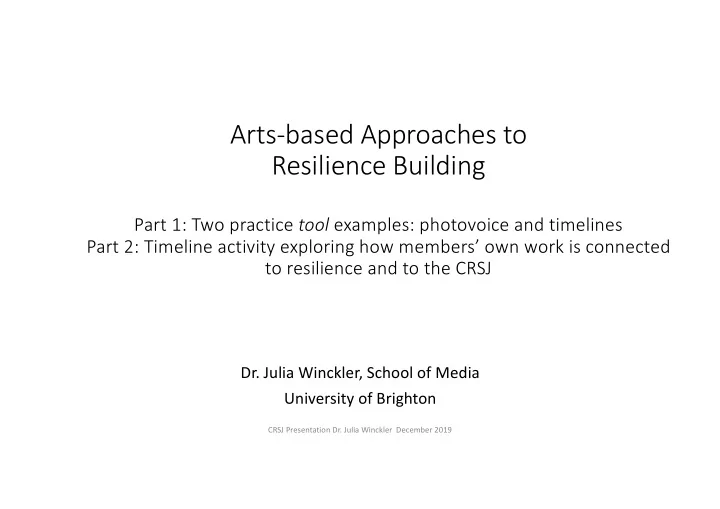

Arts-based Approaches to Resilience Building Part 1: Two practice tool examples: photovoice and timelines Part 2: Timeline activity exploring how members’ own work is connected to resilience and to the CRSJ Dr. Julia Winckler, School of Media University of Brighton CRSJ Presentation Dr. Julia Winckler December 2019
MJM07 Participatory Media Production for Social Change CRSJ Presentation Dr. Julia Winckler December 2019
CRSJ Presentation Dr. Julia Winckler December 2019
Syst Systemic and community based approach to resilience culturally relevant – culturally sustaining pedagogy asset-based community development Creating an interpretive space for plural interpretations (ways of making meaning) Django Paris, H. Samy Alim Culturally sustaining pedagogies: Teaching and Learning for Justice in a Changing World , 2017 CRSJ Presentation Dr. Julia Winckler December 2019
Developing greater empathy and deeper self-awareness among each other and for ourselves as practitioners/educators/researchers/artists/invididuals Art is an enquiry into the creative process, an interplay with the intellect and intuition. Art is felt with the whole human being, not just in the senses – emotionally, socially, and intellectually. (Djon Mundine, 2017) CRSJ Presentation Dr. Julia Winckler December 2019
The use of visual tools and arts- Visual tools and arts-based approaches based approaches in the research as part of the research product: process: to document findings to establish identity to tell a story develop relationships present ideas record events and observations to ground theory check biases reflect analysis (on multiple levels) survey physical/social features advocate a position engage with others to co-produce demonstrate an approach knowledge bring data to life provoke responses synthesize to interview inspire action to review to document This model has been adapted from a model presented by Prof. Deborah Barndt as part of a talk on “Media and Cultural Production as Forms of Research and Communications”. CRSJ Presentation Dr. Julia Winckler December 2019
There is always a context within which we work as artists/ educators/lecturers/practitioners Different roles of educators: so much is in the naming we adopt : facilitator, tutor, mentor, teacher, collaborator, conduit (transmitter or channel)? Traditional Education vs. Popular Education Critical Pedagogy: the art of education CRSJ Presentation Dr. Julia Winckler December 2019
Art Art and nd po popul pular r educ ducation: n: st starting with the participants Pa Paulo Fr Freire (1 (1921-1997) 1997), Br Brazilian educator or; con ontext of of his wor ork was Sou outh Am America initially Pedagogy of the Oppressed : one of the most quoted educational texts in Latin America, Asia, Africa Pedagogy of Hope: Reliving Pedagogy of the Oppressed - written as a reflection on Pedagogy of the Oppressed CRSJ Presentation Dr. Julia Winckler December 2019
Th The Hi Highlander Folk School and and the hen n Hi Highlander Research and Education Centre - 1932 1932 on onwards CRSJ Presentation Dr. Julia Winckler December 2019
TO TOE manifesto ht http://ka kaitak.hkbu.edu.hk/a /about-us us/thr hroug ugh-ou our-ey eyes/ • train and engage the senses • ethical practice for a better world • ‘art education is a key we pass on’: helps learners to respond to the world around them • return art to young people • seeing ourselves in our students • growing together • we are educators, but before that, we are all human beings: see lessons as a form of interaction between human beings • bring passion to nurture passion • focus on potential • Focused on the individual, not on the work: process as important as outcome • Give everyone a chance to learn • Art for all students • Year of self reflection for AEs – value of art education is often ignored – impact and value of art: how can it be measured • What is the meaning of education: curiosity, probe and participate in learning processes, independent thinking, Defining a project through ‘success’ or ‘failure’ obscures the learning that takes place • • Describes process of self awareness and ‘conscientisation’ (see P. Freire) CRSJ Presentation Dr. Julia Winckler December 2019
CRSJ Presentation Dr. Julia Winckler December 2019
Historical Mapping timeline You may draw your personal timeline on a A3 or A4 paper, no limitation on the starting and ending point. No standard format and content. Consider this: When did you first begin to engage with the concept of resilience? When did you start using and ‘owning’ it? Do you use it in your work? Have your interpretations of resilience changed over time? Mark references to resilience (conferences, projects, experiences on your timelines) CRSJ Presentation Dr. Julia Winckler December 2019
Historical mapping exercise: collective Making a collective CRSJ TIMELINE, naming key moments, and connecting with each other SHARE! CRSJ Presentation Dr. Julia Winckler December 2019
Recommend
More recommend